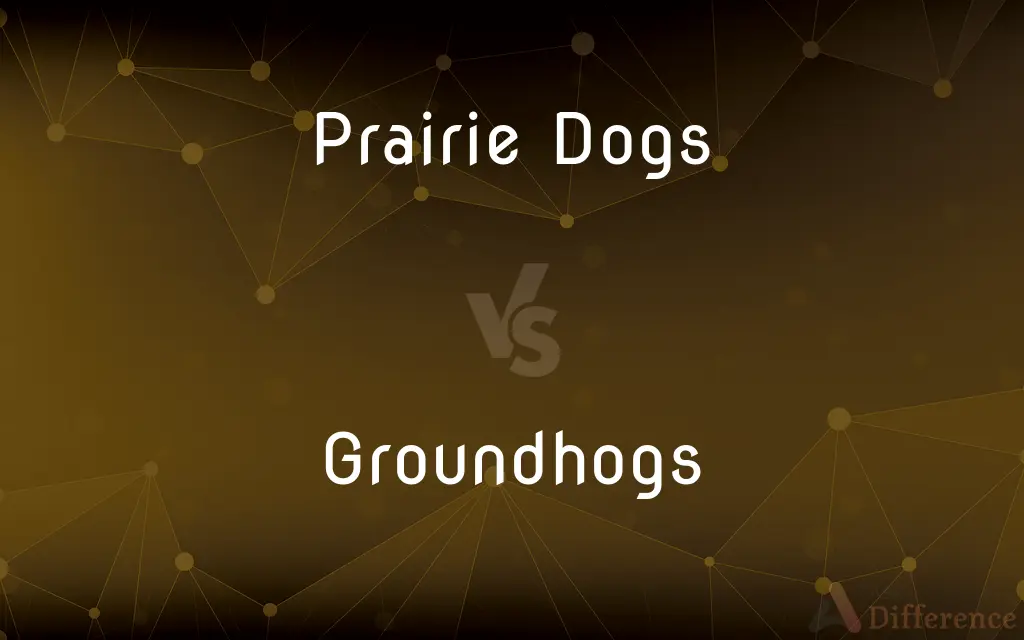Prairie Dogs vs. Groundhogs — What's the Difference?
By Tayyaba Rehman — Published on January 21, 2024
Prairie dogs are small, social rodents living in large colonies in North America, while groundhogs are larger, solitary animals known for burrowing, found in North America and Canada.

Difference Between Prairie Dogs and Groundhogs
Table of Contents
ADVERTISEMENT
Key Differences
Prairie dogs belong to the squirrel family and are known for their complex social structures, living in large colonies or 'towns'. They are smaller in size and have a more rounded and compact body shape. Groundhogs, also known as woodchucks, are part of the same family but are larger and have a stockier build. They are known for their solitary nature, except during the mating season.
In terms of habitat, prairie dogs are primarily found in the grasslands of North America, where they dig extensive burrow systems. Groundhogs are more versatile in their habitat choice, residing in woodlands, fields, and even in proximity to human environments. They also create burrow systems but tend to be less complex than those of prairie dogs.
Prairie dogs communicate with a variety of sounds and have a sophisticated language, especially to alert each other to predators. Groundhogs are less vocal and rely more on physical posturing and scent marking for communication.
Prairie dogs have a significant ecological role in their environment, helping to aerate the soil and disperse seeds. Groundhogs, while also influential in soil aeration, are often considered pests in urban and agricultural areas due to their burrowing habits.
In cultural aspects, groundhogs are famously associated with Groundhog Day in North America, a tradition where the groundhog’s behavior is said to predict the arrival of spring. Prairie dogs, while not associated with any specific cultural events, are often a subject of interest due to their complex social behaviors and interactions.
ADVERTISEMENT
Comparison Chart
Family
Squirrel family
Same family as prairie dogs
Size and Build
Smaller, rounded body
Larger, stockier build
Habitat
Grasslands of North America
Woodlands, fields, and near humans
Social Structure
Live in large colonies
Mostly solitary animals
Ecological Role
Aerate soil, seed dispersal
Soil aeration, considered pests in some areas
Compare with Definitions
Prairie Dogs
Prairie dogs are small rodents living in colonies.
The prairie dogs were seen popping out of their burrows on the grassland.
Groundhogs
Groundhogs are large rodents known for burrowing.
A groundhog was spotted digging a burrow in the backyard.
Prairie Dogs
They have a complex social structure.
Prairie dogs communicate with each other using a variety of sounds.
Groundhogs
Groundhogs are associated with Groundhog Day.
The legend of Groundhog Day revolves around the groundhog’s shadow sighting.
Prairie Dogs
Prairie dogs live in extensive burrow systems.
The prairie dog burrows were interconnected, forming a large underground network.
Groundhogs
They are also called woodchucks.
The woodchuck, or groundhog, has emerged as a sign of spring.
Prairie Dogs
Prairie dogs are found in North America’s grasslands.
He observed a large prairie dog town while hiking in the Great Plains.
Groundhogs
Groundhogs are found in North America and Canada.
Groundhogs are common in both the forests and urban areas of Canada.
Prairie Dogs
They play a role in aerating soil and seed dispersal.
The presence of prairie dogs helps maintain the health of the grasslands.
Groundhogs
They are solitary except during mating season.
The groundhog lived alone in its burrow except during the early spring.
Common Curiosities
How do prairie dogs communicate?
They use a variety of sounds to communicate, especially for predator alerts.
Do prairie dogs have an important ecological role?
Yes, they help in aerating the soil and seed dispersal.
What family do prairie dogs belong to?
They belong to the squirrel family.
Are prairie dogs social animals?
Yes, they live in large colonies and have complex social interactions.
Do groundhogs live in colonies like prairie dogs?
No, groundhogs are mostly solitary animals.
Are groundhogs considered pests?
In some urban and agricultural areas, they are considered pests due to their burrowing habits.
Are groundhogs and woodchucks the same?
Yes, groundhogs are also known as woodchucks.
What is the significance of Groundhog Day?
It's a tradition where the groundhog’s behavior is believed to predict the arrival of spring.
Can you find prairie dogs in urban areas?
They are mostly found in grasslands and not typically in urban areas.
Where can you typically find groundhogs?
In woodlands, fields, and sometimes near human environments.
How do groundhogs affect the soil?
Their burrowing activity helps aerate the soil.
How large are prairie dog colonies?
They can be quite large, with some comprising hundreds of individuals.
What type of habitat do prairie dogs prefer?
They prefer open grasslands.
Do groundhogs have a specific mating season?
Yes, they typically mate in early spring.
Are prairie dogs active throughout the year?
They are active most of the year but may go into torpor in winter.
Share Your Discovery

Previous Comparison
Poke Bowl vs. Chirashi
Next Comparison
EK vs. EGAuthor Spotlight
Written by
Tayyaba RehmanTayyaba Rehman is a distinguished writer, currently serving as a primary contributor to askdifference.com. As a researcher in semantics and etymology, Tayyaba's passion for the complexity of languages and their distinctions has found a perfect home on the platform. Tayyaba delves into the intricacies of language, distinguishing between commonly confused words and phrases, thereby providing clarity for readers worldwide.
















































